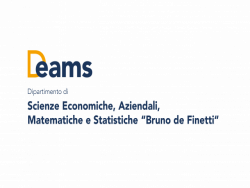- Home
- Dipartimento
- Ricerca
- Didattica
- Corsi di laurea
- Corsi di studio
- Informazioni agli studenti
- Elenco insegnamenti - Programmi d'esame
- Archivio Elenco Insegnamenti - Programmi
- Orario delle lezioni e Calendario didattico
- Bacheca appelli Guida Online
- Calendario lauree
- Informazioni specifiche Calendario lauree
- Segreteria studenti
- Bandi
- Collegio universitario Luciano Fonda
- Mobilità internazionale
- Premi di studio
- Orientamento
- Sbocchi professionali
- Stage e tirocini
- Modulistica di Ateneo
- Post Lauream
- Servizi e strumenti
- Trasferimento della conoscenza
Business Management (2009-2010)
Anno Accademico:
2009-2010
Insegnamento:
041EC
Business Management
Docente:
Andrea Tracogna
Obiettivi:
This is an introductory course to business management
Collegamento con altri insegnamenti:
Financial Accounting, Marketing, Organisation
Programma:
1. Theory of the Firm, Corporate Governance and Organization
- What’s a firm?
- Different types of firms
- Firms and entrepreneurs
- The Firm as an input-output system: measures of efficiency, effectiveness, productivity
- Stakeholders’ analysis
- Profit maximization and the firm’s objectives
- Corporate social responsibility
- Fundamentals of corporate governance.
- Firm’s organization: principles and structures
2. Cost-Profit Analysis
- Different types of costs: fixed, variable, direct, indirect, average, marginal, opportunity
- Cost structures, operating leverage and cost elasticity
- Contribution margin analysis
- Prices and revenue management (yield management)
- Break even point and break-even sales
- Mark-up method
3. Value Creation
- Residual income (Economic Value Added).
- NOPAT and WACC.
- Financial structure (Debt vs. Equity) and cost of capital
- Working capital cycle and financial needs.
- Levers of value maximization
4. Value Chain and Value System
- Primary and supporting activities
- Make/buy decisions and vertical integration
- Outsourcing, offshoring and virtual corporations
- Supply chains and value systems
5. Firm’s Size
- Volume economies and scale economies
- Learning economies
- Economies of scope: sinergies and complementarities
- Economies of agglomeration
- Measures of firm’s size
- Small businesses vs. big corporations
6. Italian Entrepreneurial System
- The role of small and family businesses
- Industrial clusters
- Made in Italy and global competition
7. Analysis of Competitive Systems
- Industry analysis and SCP framework
- Competitive analysis and strategic groups
- Enlarged competition and five forces model
- Entry and exit barriers and competitive dynamics
8. Firm’s Strategies
- Strategic resources
- SWOT analysis
- Business definition
- Types of competitive advantage
- Cost strategies and differentiation strategies
- Focus strategies
- Growth strategies
9. Operations Management
- Industrial production vs. craftmanship
- Production of goods and services
- Different types of production processes
- Different layouts
- Make to order vs. make to stock
- The choice of production capacity
- Performance measurement in Operations
10. Supply chain management
Procurement and Inventory Management
- Direct vs. indirect purchasing
- The functions of Inventories
- Safety stocks
- Costs of inventories
- Fixed-time vs. fixed-lot procurement
Suppliers Management
- Kralijic Matrix: stability vs. efficiency in suppliers management
- Vendor selection and vendor rating
- Multiple vs. single sourcing
Logistics Management
- Cost-service trade off
- Measures of logistics performance
Distribution Management
- Distribution channels
- Distribution strategies
- Brand loyalty vs. store loyalty
- Sell-in vs. sell-out. Trade marketing
Supply chains as dynamic complex systems.
- The beer-chain simulation
- Optimization and integration in supply chains
PART A:
1. Theory of the Firm, Corporate Governance and Organization
- What’s a firm?
- Different types of firms
- Firms and entrepreneurs
- The Firm as an input-output system: measures of efficiency, effectiveness, productivity
- Stakeholders’ analysis
- Profit maximization and the firm’s objectives
- Corporate social responsibility
- Fundamentals of corporate governance.
- Firm’s organization: principles and structures
2. Cost-Profit Analysis
- Different types of costs: fixed, variable, direct, indirect, average, marginal, opportunity
- Cost structures, operating leverage and cost elasticity
- Contribution margin analysis
- Prices and revenue management (yield management)
- Break even point and break-even sales
- Mark-up method
3. Value Creation
- Residual income (Economic Value Added).
- NOPAT and WACC.
- Financial structure (Debt vs. Equity) and cost of capital
- Working capital cycle and financial needs.
- Levers of value maximization
4. Value Chain and Value System
- Primary and supporting activities
- Make/buy decisions and vertical integration
- Outsourcing, offshoring and virtual corporations
- Supply chains and value systems
5. Firm’s Size
- Volume economies and scale economies
- Learning economies
- Economies of scope: sinergies and complementarities
- Economies of agglomeration
- Measures of firm’s size
- Small businesses vs. big corporations
6. Italian Entrepreneurial System
- The role of small and family businesses
- Industrial clusters
- Made in Italy and global competition
7. Analysis of Competitive Systems
- Industry analysis and SCP framework
- Competitive analysis and strategic groups
- Enlarged competition and five forces model
- Entry and exit barriers and competitive dynamics
8. Firm’s Strategies
- Strategic resources
- SWOT analysis
- Business definition
- Types of competitive advantage
- Cost strategies and differentiation strategies
- Focus strategies
- Growth strategies
PART B
9. Operations Management
- Industrial production vs. craftmanship
- Production of goods and services
- Different types of production processes
- Different layouts
- Make to order vs. make to stock
- The choice of production capacity
- Performance measurement in Operations
10. Supply chain management
Procurement and Inventory Management
- Direct vs. indirect purchasing
- The functions of Inventories
- Safety stocks
- Costs of inventories
- Fixed-time vs. fixed-lot procurement
Suppliers Management
- Kralijic Matrix: stability vs. efficiency in suppliers management
- Vendor selection and vendor rating
- Multiple vs. single sourcing
Logistics Management
- Cost-service trade off
- Measures of logistics performance
Distribution Management
- Distribution channels
- Distribution strategies
- Brand loyalty vs. store loyalty
- Sell-in vs. sell-out. Trade marketing
Supply chains as dynamic complex systems.
- The beer-chain simulation
- Optimization and integration in supply chains
Testi consigliati:
All the teaching material is available for download at www.econ.units.it
Ultimo aggiornamento: 11-12-2013 - 16:27



